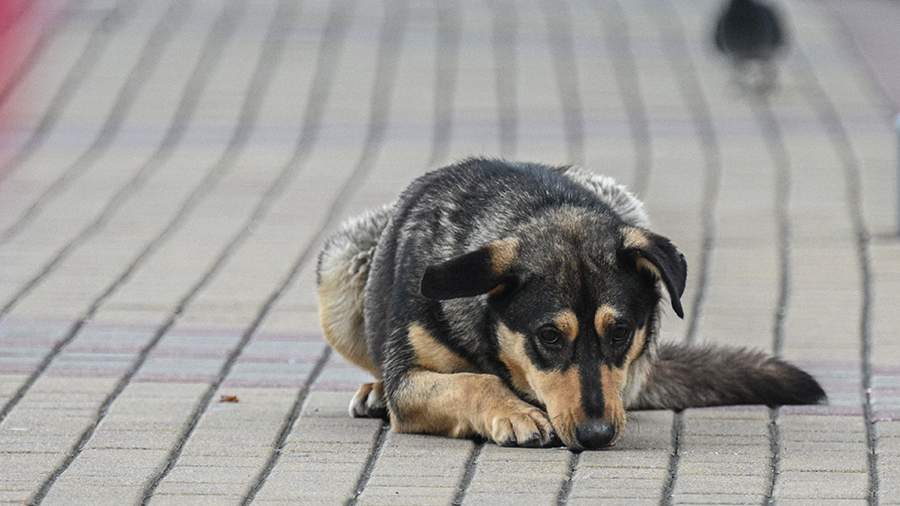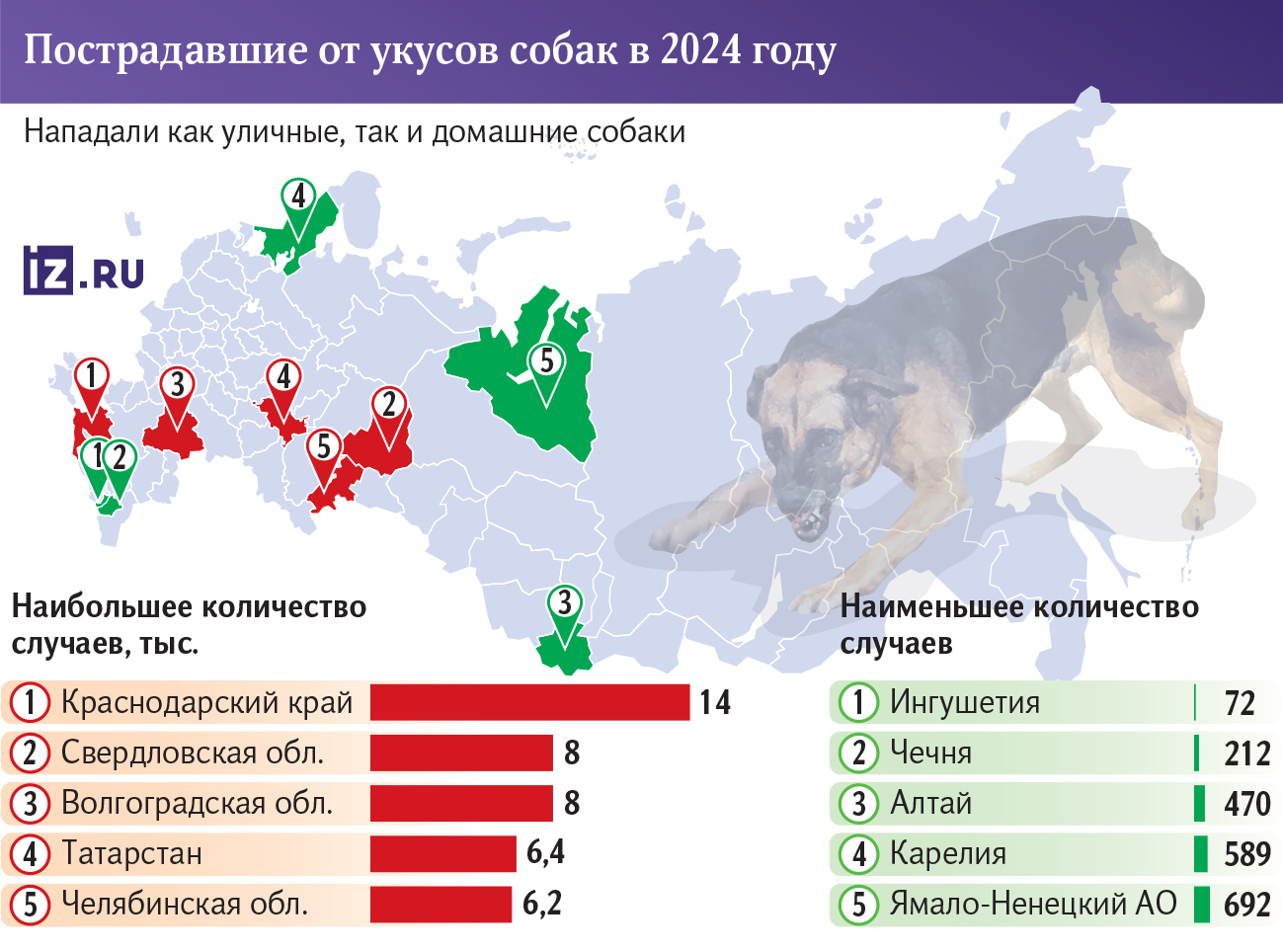Dog farce: Krasnodar Region has become an anti-leader in animal attacks

The Krasnodar Territory recorded the largest number of victims of dog bites in 2024 — people sought medical help more than 14 thousand times, the local Rospotrebnadzor reported. The Sverdlovsk and Volgograd regions were in second or third place, according to a study by Izvestia, with 8,000 attacks recorded there. At the same time, almost 4.5 billion rubles were allocated for programs for trapping and sterilizing stray animals throughout Russia last year. In some regions, this amount exceeded 200 million rubles, and in the Krasnodar Territory it amounted to 159.5 million rubles. Experts believe that the main reason for the inefficiency of spending funds is contracts with unscrupulous contractors. Read more about the problem in the Izvestia article.
Where dogs were bitten most often
The Krasnodar Territory became the anti-leader among Russian regions in the number of dog attacks on humans in 2024, Izvestia found out after examining data from 60 regional departments of Rospotrebnadzor. In total, doctors in the region recorded more than 14 thousand bites — 7% more than in 2023. In January–February 2025, the number of such incidents in the region has already reached almost 2.5 thousand.
The last high-profile case occurred in March of this year. A pack of dogs attacked teenagers in Ust-Labinsk, the Investigative Committee of the Krasnodar Territory reported. Three young men decided to explore the motocross track, where they were attacked by animals. As a result, the teenagers were hospitalized in the trauma department.
Dog attacks were also actively recorded in the Sverdlovsk and Volgograd regions — 8 thousand cases per year. Among the regions studied by Izvestia, they took the second or third places. Then comes Tatarstan, where dogs have bitten people 6.4 thousand times, and the Chelyabinsk region closes the top five with 6.2 thousand attacks.
In Chelyabinsk, a series of high-profile cases occurred in 2024. On December 17, in the village of Shagol, a stray dog attacked a 10-year-old girl and bit her leg. A month earlier, stray dogs attacked a woman there. The victim needed medical attention.
"On social networks, citizens noted that despite the large number of stray dogs in the city, no measures are being taken to capture them," the Investigative Committee said.
The federal Rospotrebnadzor told Izvestia that in total, 237 thousand people applied for medical care due to dog attacks (this also includes salivation and scratching) in 2024. This is 0.9% less than in 2023.
How much did you spend on fighting stray dogs
To solve the problem of neglected animals in Russia, there is a catch—sterilization —vaccination—release system. Budgets for its implementation are allocated by the regions themselves. Euthanasia of neglected animals is also allowed in 15 regions, and such a measure will soon become effective in two more. The executors of the program, commissioned by the authorities, are most often private companies and animal shelters.
In 2024, 4.45 billion rubles were allocated across Russia for these needs (+41% by 2023). The number of government purchases also increased from 2.4 thousand to 2.6 thousand, the Kontur service told Izvestia.Purchases". This year, financing continues to increase: in the first quarter it amounted to 1.74 billion rubles (+21% compared to the same period a year earlier). The number of contracts increased by 10%.
"The increase may indicate an expansion of programs to regulate the number of neglected animals, as well as an increase in the cost of services provided," said Vasily Danilchik, an expert at the service.
The Khabarovsk Territory spent the most on these programs in 2024 — 288.1 million rubles. During this time, about 3 thousand dog bites were recorded in the region. In 2025, the budget for OSV in the region was reduced by more than two times.
Among the leaders in the budget allocated to work with stray animals are the Khanty-Mansi Autonomous Okrug — 249.1 million rubles, Sakhalin — 243.8 million and the Krasnodar Territory — 159.1 million.
At the same time, if we recalculate the costs per 100,000 inhabitants, then the spread in expenses is tenfold. So, in Sakhalin, this figure is 53.2 million rubles, in Khabarovsk — 22.5 million, in the Krasnodar Territory — 2.7 million, and in the Volgograd Region — 1 million, Izvestia estimated.
Is OSVV working?
The HVAC system is capable of working in regions where its implementation is well-suited, said Vladimir Burmatov, first deputy chairman of the State Duma Committee on Ecology, Natural Resources and Environmental Protection.
— Now the regions have the right to decide for themselves how to deal with neglected animals: what fines to impose, how much to spend on shelters, with whom to conclude contracts. But not everyone wants to take control of the situation. The areas where the issue is being handled responsibly are showing positive dynamics. For example, Moscow or the Voronezh Region," he believes.
But some regional authorities began to abuse their powers after the introduction of the OSV program, Elvira Kutuyeva, a member of the Zoogravo Association and founder of the Angel Protects Charity Fund for the Protection of Nature and Animals, told Izvestia.
— The price in the state contract, for example, in Tatarstan, for one dog is about 4 thousand rubles, — she explained. — And the cost of sterilization of an adult dog alone is 6 thousand rubles. Additionally, the costs of trapping, transportation, maintenance, and so on. Officials generally don't care if these dogs are caught or not.
Therefore, according to her, unscrupulous trappers often become contractors. As an example, she cited the case of concluding contracts in several regions (Chuvashia, Penza, Samara and Ulyanovsk regions) with sole proprietor Sergey Madyankin, who, according to Kutuyeva, is known for questionable working methods.
— People like him are black contractors. In our region, the authorities, having heard the people, blacklisted him," said Elvira Kutuyeva. — He didn't just transport dogs from district to district and let them go, but also poisoned them. He stole the owner's dogs and then demanded a ransom from people — allegedly they had to pay maintenance costs. In addition, black contractors often do everything to make dogs much more numerous — this is how they earn money.
Sergey Madyankin, according to the animal rights activist, most often took contracts in small settlements, because it is easier to agree on the "specifics" of working with the administration there.
"In order for the flow of stray dogs not to decrease, he came up with his own moves and loopholes," she added. — For example, the deliberate release of already pregnant bitches — there is evidence of this, at least ultrasound. That is, they make incisions in the abdominal cavity and simulate sterilization, or they just make a seam, or they cut the reproductive organs of dogs, but do not remove them.
Izvestia tried to contact Sergey Madyankin, but received no response.
The problem of homeless animals requires a systematic approach, not spontaneous solutions, said Ekaterina Kosareva, Managing partner of the analytical agency VMT Consult. The HIA was conceived as an effective measure, but due to gaps in control, it does not always achieve its goal.
"If the OSV program is carried out in good faith — with real sterilization, vaccination and control of released animals, this will create a safe environment for both humans and dogs," she believes.
Where is the most difficult situation
The Astrakhan and Orenburg regions, Yakutia and Buryatia were named in the Commission on Ecology and Sustainable Development of the Civic Chamber of the Russian Federation among the regions where problems with environmental pollution are most pronounced.
Not all regions properly investigate and analyze the number of stray animals, as well as the number of excesses with them, as indicated in a special report by the OP of the Russian Federation. When there is no monitoring data, it is impossible to properly plan budget financing and effectively spend money, they noted. In addition, regional authorities do not always have reliable information about municipal activities.
"Often, information about the availability and capabilities of non—governmental animal shelters is not collected on an ongoing basis and is not analyzed," the report emphasizes.
40% of all attacks are caused by domestic dogs, which the owners let loose on their own, said Vladimir Burmatov. Federal law prohibits this, but pet owners regularly violate it.
Often, the owners do not work on the socialization of such animals. Once they are free, they can attack a person because they simply do not know how to behave with him. Stray dogs attack only if they are defending their territory, food or a pregnant female, adds cynologist Alexander Shekyan.
In March 2025, deputies submitted to the State Duma a bill proposing to deprive shelters of the right to return stray animals to their former habitats. It was assumed that the initiative would also give the subjects the right to kill them after the deadline for detention. The regions would have to determine this period independently.
— Returning an animal after sterilization does not guarantee that it will not behave aggressively. Instincts are preserved anyway. No one knows if the dog will end up being a danger to society," Nina Ostanina, one of the authors of the bill, chairman of the Committee on Family Protection, Fatherhood, Motherhood and Childhood, told Izvestia.
The initiative was also supported by the Investigative Committee. The department reported that during the implementation of the OSV, the number of criminal cases under investigation into dog attacks only increased. Over the past three years, it has increased more than five times. If in 2022 there were 78 criminal cases, then in 2024 there were already 408.
Nevertheless, the consideration of the draft law was postponed indefinitely, as "the formation of an opinion, taking into account the position of all interested departments, continues."
Переведено сервисом «Яндекс Переводчик»
